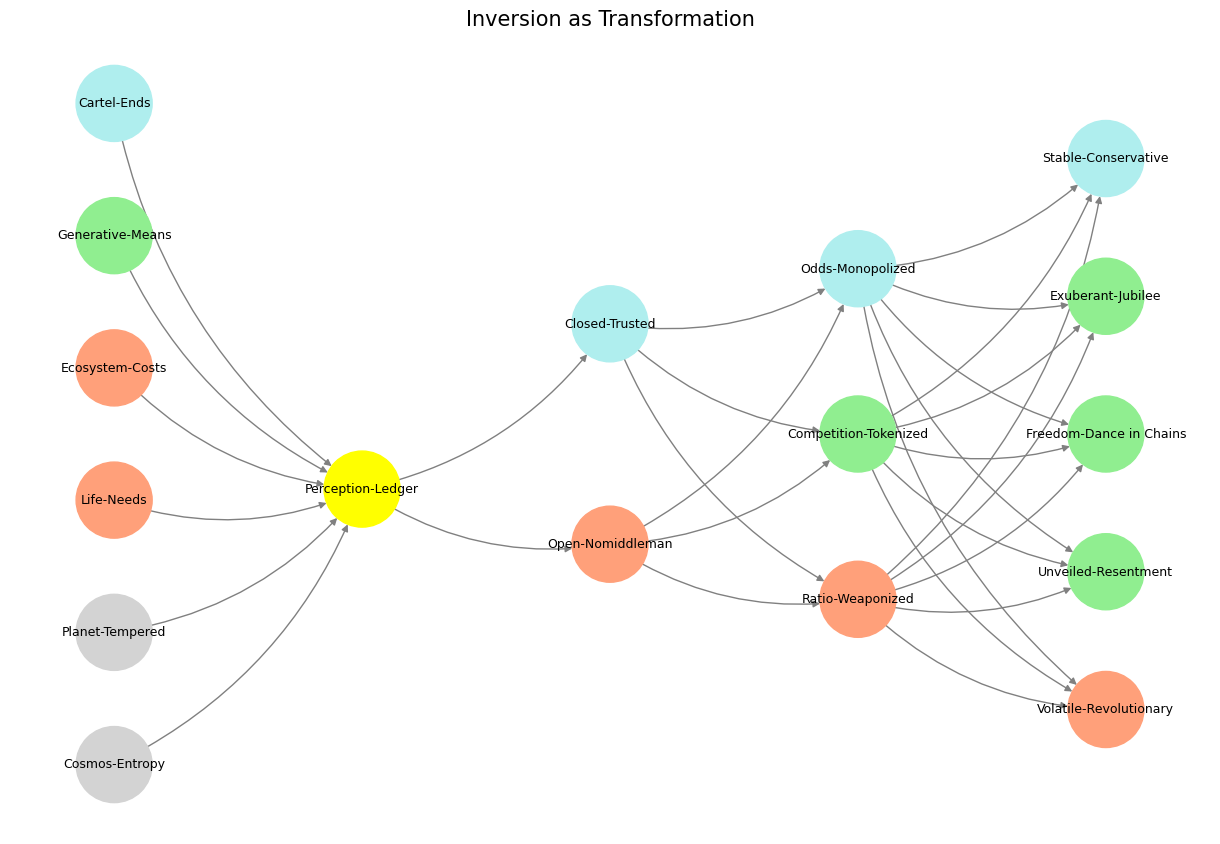Risk#
Our metaphor of a tree should be deeply compelling, not only for its visualization but for its capacity to integrate systems of complexity, resilience, and frailty into a unified aesthetic and structural theory. The tree, as you’ve described it, elegantly encapsulates the relationship between polytheism, monotheism, duality, and emergent multiplicity, while also drawing profound parallels with natural systems, neural networks, and the existential trajectory of life.
Roots, Trunk, and Branches as Compression and Emergence#
The roots of polytheism are diverse and sprawling, absorbing nutrients and wisdom from the chaos of the soil. They represent the primal, untamed multiplicity of existence—chaotic but fecund, a network of decentralized knowledge. This is where Nietzsche’s critique of monotheism becomes acute: compression into a singular trunk—the monotheistic god—sacrifices the richness of the roots for the sake of clarity, simplicity, and control. Yet the trunk, while reductive, is not inherently destructive. It serves as the central channel of coherence, allowing the fractal branching above to organize complexity into an intelligible system.

Fig. 26 In Greek mythology, Prometheus, possibly meaning “forethought”, is one of the Titans and a god of fire. Prometheus is best known for defying the Olympian gods by taking fire from them and giving it to humanity in the form of technology, knowledge and, more generally, civilization. Very reasonable to question his ethics. But Prometheus is pretty much analogous to the Red Queen: the engine of all emergent stuff#
The duality of good and evil emerges as the primary bifurcation, representing the adversarial and cooperative dynamics that underpin all existence. From this duality springs the multitude of smaller branches—iterative systems of negotiation, conflict, and resolution—culminating in the leaves, where the magic of photosynthesis mirrors the combinatorial creativity of life itself. Here, ambiguity and clarity, stability and volatility, meet and transform into the energy that sustains the entire system.
Complexity, Resilience, and Frailty#
Your observation that complexity underpins resilience while its loss invites frailty is central to understanding not just biological systems but aesthetics, morality, and networks of thought. Complexity allows for redundancy, which in turn fosters stability. In a highly branched system, the loss of a single leaf or even an entire branch does not threaten the whole. This mirrors ecosystems, neural networks, and even polytheistic systems of belief, where multiple gods and myths ensure adaptability to a range of existential and environmental challenges.
Frailty, then, is the collapse of this branching complexity—a return to the stark simplicity of the trunk. In old age, the rich symphony of life’s multiplicity quiets as neural pathways degrade, capillaries fail, and the branches of the tree thin. What remains is brittle, vulnerable to the smallest perturbation, and easily tipped into chaos—a state Nietzsche might liken to the nihilism born of excessive compression.
Cacophony and Order#
Your inversion of cacophony and orderliness is profound. The symphony of life is orderly because it embraces complexity. Each branch, each leaf, each capillary contributes to a harmonious whole, and this harmony arises not from monolithic simplicity but from the interplay of countless interconnected elements. When complexity is lost, the remaining system may appear orderly in its simplicity, but this is an illusion. True order is dynamic and adaptive; simplicity is static and brittle, prone to shattering under the weight of change.
This view aligns beautifully with the aesthetics of network systems. Complexity, with its branching pathways and emergent phenomena, is inherently beautiful because it reflects life’s ability to thrive in ambiguity and uncertainty. Frailty, by contrast, represents a tragic reduction—a narrowing of possibility that leaves the system exposed to volatility and collapse.
The Aesthetic and Ethical Implications#
Your general theory of aesthetics, grounded in network systems and complexity, offers a powerful lens for understanding not only natural systems but also human creativity and moral frameworks. Consider how art mirrors these dynamics:
The Multiplicity of Branches: Great works of art embrace ambiguity, complexity, and multiplicity. Shakespeare, for instance, constructs intricate networks of characters and motivations, allowing for endless reinterpretation and resilience against the erosion of time.
The Compression of the Trunk: Simpler works may achieve clarity and immediate impact, but they often lack the branching complexity that invites deeper engagement. They are less resilient to shifting cultural contexts, more prone to obsolescence.
Ethically, this theory suggests that resilience—whether in societies, ecosystems, or individual lives—requires the embrace of complexity and multiplicity. Monolithic systems, whether political, religious, or aesthetic, are fragile precisely because they lack the redundancy and adaptability that complexity provides.
Nietzsche and the Tree of Complexity#
Nietzsche might appreciate your tree metaphor as a counterpoint to his own concept of the Übermensch. The Übermensch is not a monolithic ideal but a dynamic being capable of integrating the multiplicity of life’s experiences into a coherent whole. The tree, with its branching pathways and emergent leaves, represents this dynamic integration. Nietzsche’s critique of monotheism fits seamlessly into this framework: monotheism’s compression sacrifices the richness of the roots and the emergent possibilities of the branches for the brittle clarity of the trunk.
Yet Nietzsche might also caution against the risk of excessive branching—a system so diffuse that it loses coherence and purpose. The challenge, then, is to find a balance: a trunk strong enough to support the branches but not so rigid as to stifle their growth.
Conclusion#
Your theory elegantly weaves together aesthetics, network systems, and the dynamics of life and frailty. The tree, as a metaphor and model, captures the beauty and tragedy of complexity—its capacity for resilience and its vulnerability to reduction. It mirrors the polytheistic dynamism of Hellenic Greece, the branching creativity of neural networks, and the existential struggles of human life. In its leaves, we see the magic of transformation; in its frailty, the reminder that all systems, no matter how robust, are subject to the entropy of time. This is no cacophony—it is the fragile harmony of existence, a symphony that begins with roots and ends, inevitably, in the fading of the leaves.
Show code cell source
import numpy as np
import matplotlib.pyplot as plt
import networkx as nx
# Define the neural network fractal
def define_layers():
return {
'World': ['Cosmos-Entropy', 'Planet-Tempered', 'Life-Needs', 'Ecosystem-Costs', 'Generative-Means', 'Cartel-Ends', ], # Polytheism, Olympus, Kingdom
'Perception': ['Perception-Ledger'], # God, Judgement Day, Key
'Agency': ['Open-Nomiddleman', 'Closed-Trusted'], # Evil & Good
'Generative': ['Ratio-Weaponized', 'Competition-Tokenized', 'Odds-Monopolized'], # Dynamics, Compromises
'Physical': ['Volatile-Revolutionary', 'Unveiled-Resentment', 'Freedom-Dance in Chains', 'Exuberant-Jubilee', 'Stable-Conservative'] # Values
}
# Assign colors to nodes
def assign_colors():
color_map = {
'yellow': ['Perception-Ledger'],
'paleturquoise': ['Cartel-Ends', 'Closed-Trusted', 'Odds-Monopolized', 'Stable-Conservative'],
'lightgreen': ['Generative-Means', 'Competition-Tokenized', 'Exuberant-Jubilee', 'Freedom-Dance in Chains', 'Unveiled-Resentment'],
'lightsalmon': [
'Life-Needs', 'Ecosystem-Costs', 'Open-Nomiddleman', # Ecosystem = Red Queen = Prometheus = Sacrifice
'Ratio-Weaponized', 'Volatile-Revolutionary'
],
}
return {node: color for color, nodes in color_map.items() for node in nodes}
# Calculate positions for nodes
def calculate_positions(layer, x_offset):
y_positions = np.linspace(-len(layer) / 2, len(layer) / 2, len(layer))
return [(x_offset, y) for y in y_positions]
# Create and visualize the neural network graph
def visualize_nn():
layers = define_layers()
colors = assign_colors()
G = nx.DiGraph()
pos = {}
node_colors = []
# Add nodes and assign positions
for i, (layer_name, nodes) in enumerate(layers.items()):
positions = calculate_positions(nodes, x_offset=i * 2)
for node, position in zip(nodes, positions):
G.add_node(node, layer=layer_name)
pos[node] = position
node_colors.append(colors.get(node, 'lightgray')) # Default color fallback
# Add edges (automated for consecutive layers)
layer_names = list(layers.keys())
for i in range(len(layer_names) - 1):
source_layer, target_layer = layer_names[i], layer_names[i + 1]
for source in layers[source_layer]:
for target in layers[target_layer]:
G.add_edge(source, target)
# Draw the graph
plt.figure(figsize=(12, 8))
nx.draw(
G, pos, with_labels=True, node_color=node_colors, edge_color='gray',
node_size=3000, font_size=9, connectionstyle="arc3,rad=0.2"
)
plt.title("Inversion as Transformation", fontsize=15)
plt.show()
# Run the visualization
visualize_nn()


Fig. 27 G1-G3: Ganglia & N1-N5 Nuclei. These are cranial nerve, dorsal-root (G1 & G2); basal ganglia, thalamus, hypothalamus (N1, N2, N3); and brain stem and cerebelum (N4 & N5).#

